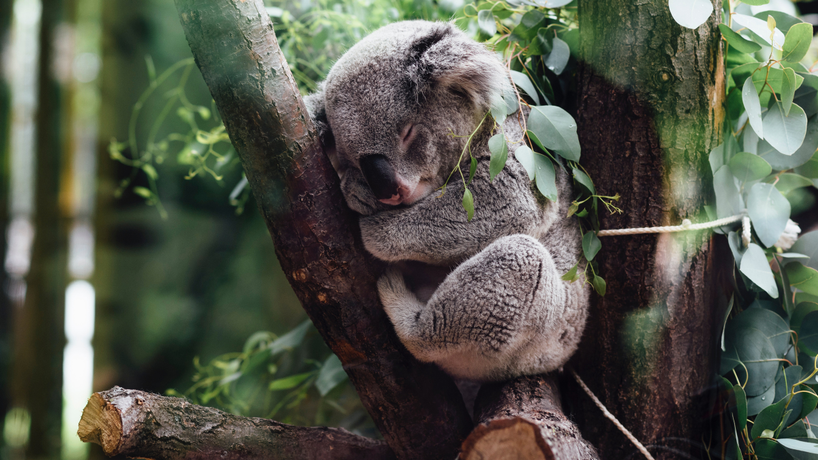
How Do Animals Sleep?
Shelly Weaver-CatherWhat separates man from the animals? A lot, surely.
But how do our sleep habits compare to those of the animal kingdom? The needs and habits of different species vary just about as much as appearances do, but there’s a common thread keeping us together—circadian rhythm. It keeps all of us, from humans to whales, moving at our own pace, which can range from a familiar 24-hour clock to much more unique, sometimes weeks long calendar. Every living thing runs by this internal clock that communicates when we need more rest, or when we’re ready to tackle a new task. Animals who seem to have lost their day-to-day circadian rhythm all-together dial into the seasonal needs of their species and live by a longer clock.
Venture away from this commonality, however, and things start to get weird, fast. Some need 18 hours of sleep a day to keep forging ahead through the world, where others only require a quick minute-long power naps stay the course. (We have to admit, we’re a bit jealous of both.)

Strange Forms Animals face challenges that we haven’t had to concern ourselves with in centuries. Predators make sleeping a bit of a gamble, but if done in the right place, at the right time, waking up is much more likely. Meerkats have a whole system figured out—they keep their matriarch on the bottom of a warm and cozy huddle, so she gets the best sleep possible. They keep a few off to the sides as “sentries” who don’t get all the way into REM so they can stay alert and listen for any ill-intended foes.
Unlike the meerkat, sea lions will sleep just about anywhere, anytime. They don’t have to fear too many predators on land, and can often be spotted snoozing on benches and bouys in well-populated areas.
The brown bat sleeps upside down, as most of us know, but perhaps not for the reason you might think. Bats actually have pretty weak wings, so when they are ready to wake (For the 6 or so hours a night they don’t spend slumbering.) it’s much easier for them to release their grip and drop into the air instead of taking off from the ground.
Sperm whales, one of the world’s largest creatures, sleep vertically, bobbing up and down below the surface of the water. It wasn’t until about ten years ago that we were able to conclusively say how these behemoths slept, as documented by french photographer Stephane Granzotto. He witnessed the whales sleeping this way for almost an hour, though it’s thought that they are one of the least sleep-dependent species. Data tagging leads us to believe that they spend about 7% of their day inactive, compared to our 33%.

Shut It Down Many animals only shut down part of their brain while they rest as a way to keep an eye on things. Known as unihemispheric sleep, many marine animals like bottlenose dolphins and beluga whales shut down part of their brain to take a break, while the other half stays alert and manages surfacing and breathing. Marine animals that still need oxygen adapted over time to still be able to get the rest they need to survive without drowning.
Birds also sleep with one eye open. Smaller birds, like blackbirds, are easy victims if they aren’t constantly aware of their surroundings. Larger birds, like penguins, not only stay partially awake to make sure no one is encroaching on their territory, but they actually sleep standing up. Because they live in colder environments, leaving only their extremely well-insulated feet in contact with the freezing ground helps keep them warm while they recover.
Sharks also can shut down parts of their brain during sleep. You’ve probably heard that sharks can’t survive if they stop moving, and for most species that’s true. They have to keep water flowing over their gills to get oxygen into their systems, but that doesn’t mean they are always awake. The part of the brain that controls their movements stays with it and keeps them gliding through the ocean while they snooze. Researchers found when studying the spiny dogfish, a species of shark usually found near the ocean floor, that the part of the brain that typically controls the signals that keep animals moving and breathing actually wasn’t located in the brain of the shark at all—but in the spine. This may mean that the spiny dogfish is able to shut its brain off while still surviving just fine.

Cat Naps Some animals barely need any sleep at all. Giraffes can function on as little as 30 minutes of sleep a day, usually acquired through blink-and-you’ll-miss-them power naps. Because of their height, the time and attention it takes to get up and down leaves them vulnerable to predators, so they avoid it all costs. Until the 1950s, researchers actually assumes they didn’t sleep ever, they napped so infrequently and quickly.
Bull frogs have a strange habit of never actually getting real sleep—outside of their winter hibernation, of course. Instead of letting themselves drift off to sleep, their brains stay almost entirely alert and ready to respond to any potential threats in their environment. Although, if you spent months at a time in hibernation, you’d probably be good to go for the rest of the year, too.
Orca calves go the first few months of their lives without sleeping at all. While there isn’t a definitive answer as to why, it’s thought that they may need to stay more alert in case of predators, as they stay awake even while their parents sleep. It could also be to keep them warm, while they work on growing and insulating their bodies with blubber.



